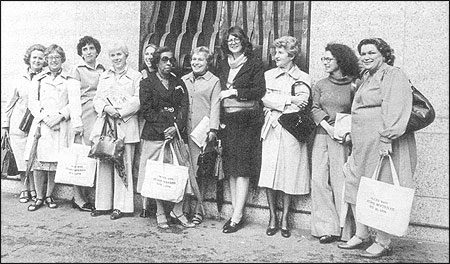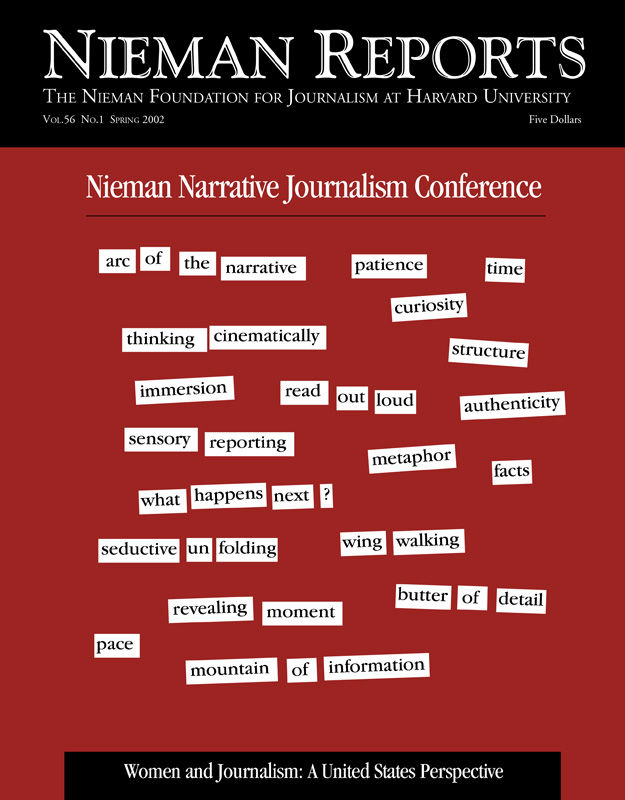
Women journalists gathered at the federal courthouse in New York City’s Foley Square on October 6, 1978 when the gender discrimination lawsuit, Boylan et al. v. The New York Times, was settled. Photo courtesy of Barbara Dubivsky.
The state of women in journalism today is one of those half-full, half-empty things. We no longer sit in the balcony, but neither do we have the best seats in the house.
During the past three decades, women in journalism as well as women in countless other fields have demonstrated what we always knew: We could do any job at least as well as men. At newspapers, magazines, radio and television stations, women have changed the very definition of news and, with it, the nation’s political agenda. As more and more women entered newsrooms, we brought new sensibilities. Stories about education, welfare, children and the elderly have landed in greater numbers on the front pages of the nation’s most esteemed newspapers. Stories from war-torn countries have taken on more of a human face, and stories from our own backyards have spawned public responses to homelessness, domestic abuse, and child prostitution.
Betsy Wade, whose married name (Boylan) topped the 1970’s discrimination suit against The New York Times, likens the sensitivities of women journalists to those of a nursery-rhyme pussycat. In London, our feline protagonist is indifferent to the queen, choosing instead to zero in on a mouse beneath the throne. “You see what you’re looking for, what you’re accustomed to,” Wade says.
And women, as well as minorities, see things differently than white men do. Each of these perspectives enriches news coverage. Without each, a part of our society would be less visible. Without each, the picture of who we are would be incomplete.
Newspapers of yesteryear did not cover the waitress struggling to keep her family together or the single mom striving to balance work and home or the female college graduate blazing a trail in the corporate hierarchy. By the 1950’s and 1960’s, a few pioneering women’s page editors reflected women’s concerns about education, the economy, and the environment, but many feature sections still read as though women’s principal preoccupation was how to remove ink stains from a shirt.
Newspapers not only failed to adequately cover the lives and interests of women and minorities, they insulted them by treating them as second-class citizens, or worse, as invisible. That has changed dramatically, though not dramatically enough. The overarching voice remains that of the white man. To succeed, many women and minority journalists have learned to emulate that voice. Still, the presence of women and racial and ethnic minorities in newsrooms and on editorial pages has prompted media outlets to pay more attention to such issues as racial profiling and date rape, raising public awareness to a level that could provoke change.
The emergence of women and minorities in newsrooms coincided, of course, with similar shifts in the nation as a whole. No longer do news organizations need to report on the first woman police officer in a given city, but we might cover the first woman police chief. Ditto with women in newsrooms. While women have broken through countless barriers and held every position from publisher on down, the emphasis remains on “down.” Nearly three decades after lawsuits at The New York Times and The Associated Press changed the face—literally—of the news industry, precious few women have reached top management.
The shortage of women editors reverberates through the ranks. Without women decision-makers, it is tougher for women reporters to have their voices heard and get issues they see as important into print. I am not just talking about breast cancer and abortion here, though those topics remain vital. Women reporters often lead the pack on stories about the underclass, immigrants, child abuse, and racial and gender discrimination. I have done battle numerous times over stories about public housing tenants, welfare recipients or immigrants of color, news that my male editors feared would turn off those all-important white, suburban readers.
The dearth of women at the top affects not only how women are treated in the newspaper, but in the newsroom. Newspapers might champion child care on their editorial pages, but few offer it in their workplaces, making it difficult for women with children to put in the long hours required to cover many of the highest profile beats and to climb the ranks of editors. Parenthood has sidelined the careers of more than a few newswomen.
With an eye toward improving the lot of women in the media, a handful of women got together in 1985 to create the Journalism & Women Symposium (JAWS). Now larger and national in scope, JAWS works to support the personal growth and professional empowerment of women in newsrooms and to advocate a more accurate portrayal in the media of society as a whole. In 1998, for example, Sharon Rosenhause, then with The (San Francisco) Examiner, led a successful JAWS campaign to convince the American Society of Newspaper Editors to include women as well as minorities in its newsroom census. The idea was to track women’s progress—or lack of it—in newsrooms.
JAWS annual gatherings focus attention on such topics as women’s health, women in technology, women in the military, women in sports. JAWS also provides a solid network of support for women facing challenges in newsrooms across the country. “When you’re one of the only women in a situation, you have to find others to confirm your sanity,” explains Wade, who, in 1956, was the first woman hired onto the copy desk of The New York Times.
Two decades later, when Betsy Wade became the named plaintiff in Boylan et al. v. The New York Times, a male colleague asked her if she really wanted his job. “No, I don’t want your job,” Wade told him. “I want an equal shot at the job beyond yours.” Which, she says today, “I never got, of course.”
Undoubtedly, the atmosphere in newsrooms has improved greatly. For the most part, men and women work side by side with few problems. Men have learned not only to accept but also to appreciate women for their abilities and for their insights. Just as women now write about such “male” issues as war, politics and football, men have made their own inroads into subjects regarded as traditionally female, such as child care and job discrimination.
And women are no longer relegated to the balcony of the National Press Club in Washington, D.C.
Still, there lingers some resentment from white men who have convinced themselves that women are rising at their expense. At least three times in my career—when I was hired by The Philadelphia Inquirer, when I was assigned to cover the Pennsylvania State-house and later the White House—a white man told me point-blank that I was awarded his job strictly on the basis of gender. Upon further questioning, each man conceded my qualifications were at least as good as his were. I have seen this scene played out time and again among my colleagues.
What makes matters worse is when male editors assuage male egos by telling these bypassed men what they want to hear: that it is not their skill, but their gender that is holding them back.
In truth, male editors still practice the oldest form of affirmative action. “They hire people who went to the same school they did, who wear the same blue blazers and chinos. They hire people who remind them of themselves,” said Kay Mills, author of “A Place in the News: From the Women’s Pages to the Front Page.”
Early in her own career, Mills was told she would not be hired for a job at Newsweek because she was a woman. “I need someone I can send anywhere, like to riots,” the Chicago bureau chief told her in 1966 and she recounted in her book. “And besides, what would you do if someone you were covering ducked into the men’s room?”
Thirty-five years later, we know the answer: Follow him. Because, to a great extent, we still have to act like men.
Jodi Enda, White House correspondent for Knight Ridder newspapers, is president of the Journalism & Women Symposium.


